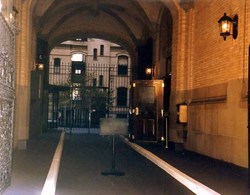New Book Sheds Light on Last Moments of John Lennon
Ever since John Lennon was tragically gunned down in 1980, it has been widely and persistently reported that the former Beatle spoke a few minutes after he was shot. Jim O'Donnell, a noted Beatles' author, refutes the story with new research, showing that Lennon did not linger in agony for minutes and speak, but rather died swiftly in seconds.
Little Silver, New Jersey (PRWEB) August 20, 2013
A newly-published book examines the 1980 shooting of John Lennon and decisively makes the case that the former Beatle died in seconds, not minutes.
Titled John Lennon Did Not Die a Slow Death, the book debunks the widely-reported story that Lennon spoke to a police officer after he was shot.
“If John had been able to talk to the cop,” said author Jim O'Donnell, “then that means he was in excruciating pain for minutes. After many interviews and going over a ton of published and unpublished reports, it became evident that John was not conscious or talking in the minutes after he was shot. The research shows that he died in seconds or even instantaneously. He did not die a slow death.”
As one piece of research, O’Donnell’s book quotes Herb Frauenberger, one of the first two cops on the scene that December night at the Dakota: “His [Lennon’s] face was right into the floor, actually, face down. He wasn’t turned left or right. His arms were spread out in front of his head, almost like you were taking a dive. He was actually turning white at that point.”
Although some of the details about Lennon’s death are graphic, they serve to show that it’s highly unlikely that the father of two died a slow death.
The frequently told story of Lennon speaking stems from the moments right after he had been shot four times, at close range, in the arched entryway of the Dakota apartments in New York City.
His bullet wounds were so severe that, instead of waiting for an ambulance, he was put into the back of a police car. According to the oft-repeated story, a policeman asked Lennon if he was, indeed, John Lennon. The story goes that Lennon nodded and said, “Yes.”
“I remember reading that story way back in 1980,” says O’Donnell, “and thinking how horrible it was that John must have been in such agony between the time he was shot and the time he was placed in the back of the police car where he supposedly spoke to a cop. I remember thinking how the seconds must have felt like hours.”
O’Donnell says that, over the years, he kept coming across the story in books and magazines when he was researching his Beatles’ book, The Day John Met Paul, which was published by Penguin. And the more he came across the story, the more he wanted to look into it.
“When you read the entire piece in my book,” said O’Donnell, “I'm confident you’ll come away thinking that the story of John talking after he was shot belongs more in the realm of urban legend than in the realm of historical record."
All of the interviews in O’Donnell’s 3000-word Lennon article were tape-recorded. There are also nine other pieces in the book, which was produced by Center Stage Media. They tell the stories of deceased people from the world of rock, including Jim Morrison, Elvis Presley, Jimi Hendrix and Janis Joplin.
O’Donnell’s first book on music was published by Pinnacle in 1975. The author’s previous Beatles’ book was acclaimed for its exhaustive research and accuracy. Pete Shotton, Lennon’s best friend as a teen, read The Day John Met Paul and said, “This is a realistic portrayal of Lennon as a teenager. O’Donnell gets it right.”
O’Donnell gets it right again in this much sadder account from the life of a much-loved musician.
“I really enjoyed writing about John as a teenager,” said O’Donnell, “and I hated writing about his murder. But at least I came away knowing he didn’t go through a slow death.”

Former Beatle John Lennon was shot to death in 1980 in this arched entryway of the Dakota apartments in New York City. (Photo by Jim O'Donnell)

No hay comentarios:
Publicar un comentario